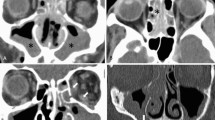Abstract
This is a retrospective study exploring the demographics and the role of nasal septum deviation in acute invasive fungal rhinosinusitis (AIFS); and if this deviation contributes to the laterality predilection of this opportunistic infection. Fifty-six craniofacial CT scans were evaluated by two radiologists blinded to the clinical data and outcome for laterality of the disease; and nasal septal deviation (NSD). NSD was graded based on the measured septal angle of deviation into mild, moderate, and severe and furtherly classified into one of seven types based on Mladina’s classification. High prevalence of remarkable nasal septum deviation existed in our population with AIFS, with type 7 Mldina NSD represented the most prevalent in this population. We found no significant statistical relation between the side of deviation and the initial side of the fungal disease. We recommend screening for early manifestations of AIFS in similar debilitated patients; with high degrees of nasal septum deviation for considering it as an anatomical risk factor.





Similar content being viewed by others
Data Availability
Available upon request.
Abbreviations
- AIFS:
-
Acute invasive fungal rhino-orbital
- NSD:
-
Nasal septal deviation
References
Turner JH, Soudry E, Nayak JV, Hwang PH (2013) Survival outcomes in acute invasive fungal sinusitis: a systematic review and quantitative synthesis of published evidence. Laryngoscope 123:1112–1118
Fouad YA, Abdelaziz TT, Askour MA, Saleh MI, Mahmoud MS, Ashour DM, Ashour MM (2021) Spike in rhino-orbital-cerebral mucormycosis cases presenting to a tertiary care center during the COVID-19 pandemic. Front Med (Lausanne) 28(8):645270
Kurokawa M, Kurokawa R, Baba A, Kim J, Tournade C, Mchugh J, Trobe J, Srinivasan A, Bapuraj J, Moritani T (2022) Deadly fungi: invasive fungal rhinosinusitis in the head and neck. Radiographics 42:2075–2094
Selarka L, Sharma S, Saini D et al (2021) Mucormycosis and COVID-19: an epidemic within a pandemic in India. Mycoses 64(10):1253–1260
Hoenigl M, Seidel D, Carvalho A, Rudramurthy SM, Arastehfar A, Gangneux JP, Nasir N, Bonifaz A, Araiza J, Klimko N, Serris A, Lagrou K, Meis JF, Cornely OA, Perfect JR, White PL, Chakrabarti A (2022) The emergence of COVID-19 associated mucormycosis: a review of cases from 18 countries. Lancet Microbe 3:e543–e552
Petrikkos G, Skiada A, Lortholary O, Roilides E, Walsh T, Kontoyiannis D (2012) Epidemiology and clinical manifestations of mucormycosis. Clin Infect Dis 54:S23–S34
Most SP, Rudy SF (2017) Septoplasty: basic and advanced techniques. Facial Plast Surg Clin North Am 25(2):161–169. https://doi.org/10.1016/j.fsc.2016.12.002
Azila A, Irfan M, Rohaizan Y, Shamim A (2011) The prevalence of anatomical variations in osteomeatal unit in patients with chronic rhinosinusitis. Med J Malaysia 66:191–194
Sharma Y, Mishra G, Pancholi K et al (2021) Does degree of nasal septal deviation measured with CT PNS have a role in management of deviated nasal septum? Indian J Otolaryngol Head Neck Surg. https://doi.org/10.1007/s12070-021-02831-2
Polat C, Dostbil Z (2010) Evaluation of the nasal mucociliary transport rate by rhinoscintigraphy before and after surgery in patients with deviated nasal septum. Eur Arch Otorhinolaryngol 267:529–535
Aribandi M, McCoy VA, Bazan C (2007) Imaging features of invasive and non invasive fungal sinusitis: a review. Radiogr Rev Publ Radiol Soc N Am 27:1283–1296
Middlebrooks EH et al (2015) Acute invasive fungal rhinosinusitis: a comprehensive update of CT findings and design of an effective diagnostic imaging model. AJNR Am J Neuroradiol 36:1529–1535
Fernandez I, Stanzani M, Tolomelli G, Pasquini E, Vianelli N, Baccarani M, Sciarretta V (2011) Sinonasal risk factors for the development of invasive fungal sinusitis in hematological patients: are they important? Allergy Rhinol 2:6–11
Oshima H, Nomura K, Sugawara M, Arakawa K, Oshima T, Katori Y (2014) Septal deviation is associated with maxillary sinus fungus ball in male patients. Tohoku J Exp Med 232:201–206
Tsai TL, Lan MY, Ho CY (2012) There is no structural relationship between nasal septal deviation, concha bullosa, and paranasal sinus fungus balls. Sci World J 1:1–4
Epstein V, Kern R (2008) Invasive fungal sinusitis and complications of rhinosinusitis. Otolaryngol Clin North Am 41:497–524
Mladina R, Čujić E, Šubarić M, Vuković K (2008) Nasal septal deformities in ear, nose, and throat patients: an international study. Am J Otolaryngol 29:75–82
Mladina R, Skitarelić N, Poje G, Šubarić M (2015) Clinical implications of nasal septal deformities. Balkan Med J 32(2):137–146. https://doi.org/10.5152/balkanmedj.2015.159957
Elahi MM, Frenkiel S, Fageeh N (1997) Paraseptal structural changes and chronic sinus disease in relation to the deviated septum. J Otolaryngol 26(3):236–240
Khademi B, Dehghan A, Zia Z, Dehghan Y (2022) Imaging spectrum of Coronavirus disease- 2019 associated rhino-orbital-cerebral mucormycosis; from sinonasal inflammation to intracranial involvement. Acad Radiol. https://doi.org/10.1016/j.acra.2022.12.011
Mohebbi A, Ahmadi A, Etemadi M, Safdarian M, Ghourchian S (2012) An epidemiologic study of factors associated with nasal septum deviation by computed tomography scan: a cross sectional study. BMC Ear Nose Throat Disord 12:15
Slonimsky G, McGinn J, Goyal N, Crist H, Hennessy M, Gagnon E, Slonimsky E (2020) A model for classification of invasive fungal rhinosinusitis by computed tomography. Sci Rep 10:12591
Acknowledgements
None
Funding
No funding was received for this study.
Author information
Authors and Affiliations
Corresponding author
Ethics declarations
Conflict of interest
None.
Ethical Approval and Consent to Participate
All procedures performed in the study were in accordance with the ethical standards of the institutional research committee and with the 1964 Helsinki Declaration and its later amendments.
Consent for Publication
For this type of study informed consent was not required and waived by the ethical committee.
Additional information
Publisher's Note
Springer Nature remains neutral with regard to jurisdictional claims in published maps and institutional affiliations.
Rights and permissions
Springer Nature or its licensor (e.g. a society or other partner) holds exclusive rights to this article under a publishing agreement with the author(s) or other rightsholder(s); author self-archiving of the accepted manuscript version of this article is solely governed by the terms of such publishing agreement and applicable law.
About this article
Cite this article
Ashour, M.M., Abdelaziz, T.T., Mahmoud, M.S. et al. Nasal Septum Deviation in Patients with Acute Invasive Fungal Rhinosinusitis in a Tertiary Care Hospital: A Cross-Sectional Study. Indian J Otolaryngol Head Neck Surg (2024). https://doi.org/10.1007/s12070-023-04438-1
Received:
Accepted:
Published:
DOI: https://doi.org/10.1007/s12070-023-04438-1




